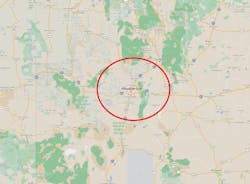It wouldn’t surprise anyone if there was an active shooter at two different locations for a food franchise on opposite ends of the country. It certainly doesn’t surprise people when there are active shooter events at different high schools – which happen to be very similar in nature, just located in different places and with different names. Why then would someone react with surprise when two different locations for the same business see separate active shooter events? This is what happened when Waid Melton was arrested for allegedly performing a shooting attack at his place of employment – the Ben E. Keith food distribution center located in Albuquerque, New Mexico – in November 2018. In August of 2018, a similar attack had occurred at the Ben E. Keith Distribution Center located on the Gulf Coast in Missouri City, Texas.
In the Missouri City incident, two employees were shot, one of them fatally. In the Albuquerque attack, Melton allegedly entered the facility on his day off and shot three employees, none of whom died. It was a Monday night, November 12, 2018, when Melton allegedly used a forklift to block the location’s doors before entering the facility and attacking his coworkers. This is not the first incident wherein a shooter blocked exits, thereby increasing his potential for "kill rate."
After allegedly shooting three coworkers, Melton left the facility and escaped to the outskirts of Albuquerque where he eventually committed suicide. Reports state that the Albuquerque police were in contact with Melton for hours before he killed himself. Police negotiators, on the phone with Melton before he took his own life, learned that he had some previously existing mental health issues, compounded by potential drug issues and that he (Melton) believed that he had been recently passed over for a promotion at work. That situation may have led to the angst that motivated his attack.
Post incident investigation revealed that the victims were not specifically selected, but were apparently the first three employees Melton encountered when he entered the facility. Further investigation supported the supposition that lack of promotion was the motivation for Melton’s attack and that due to that lack of promotion he was angry with his supervisor. Some of Melton’s family members indicated that he had pre-existing mental health issues and a search of his social media accounts revealed that he either had an interest in, or had previously used, psychedelic mushrooms, cannabis and other drugs. On his Facebook account he once claimed to be employed as a killer and on Twitter he regularly shared articles about crimes.
The police response, upon receipt of the 9-1-1 call, was immediate and somewhat overwhelming (as it should be). Officers from Albuquerque Police Department (APD), New Mexico State Police and Bernalillo County Sheriff’s Office all responded. SWAT officers made a primary and secondary search of the building to insure that it was clear of any further threat and safe for employees to enter.
After the attack, members of Melton’s family contacted the APD and gave them Melton’s cell phone number. He was contacted and was on the phone with negotiators from APD when he took his own life. The time between the attack (roughly 6:15pm) and his time of suicide (about 11:40pm) was about 5.5 hours. The forensics evidence lab technicians found a handgun near Melton’s body, inside his truck which had been towed to the facility for processing and in which Melton had committed suicide. The handgun was being tested to see if it was the weapon used in the distribution center attack, but this author can find no confirmation as to whether it was or wasn’t. Short of any other weapons being found in Melton’s possession, it’s safe to assume that it was the same weapon.
As part of the post incident investigation, a search of Melton’s residence was made, but nothing of note is reported to have been found. Waid Melton was 30 years old at the time of the attack.
This attack, like others, is perplexing due to the suicide of the suspected shooter. Without the suspect available for questioning, mental health examination, drug testing, etc. virtually all information about his mental and physical status as well as his potential motivation(s) have to be “best guesses.” While Melton’s social media feeds indicated he had an interest in drugs, this author can find no toxicology reports available for confirmation. The social media entries he made identifying himself as a killer are clearly of great concern, and should have been a red warning beacon for those who knew him and were aware of those posts.
If someone is expressing an interest in drugs, or confessing drug use, and has a history – even if it’s only suspected – of mental instability, AND embraces visualizing themselves as a killer… such person needs to be brought to the attention of the authorities. It behooves anyone with such knowledge to document it, however simply, and take it to the local law enforcement agency. Yes, this may make you a “snitch,” but failing to do so may make you, even if not legally, an accessory to the crime(s). After all, if you have knowledge and information that could be used to prevent the attack and you don’t share it, aren’t you empowering the attack?
“If you see something, say something,” isn’t just a catch phrase for anti-terrorism efforts. It applies to all crime prevention scenarios and every one of us plays a role in that effort. Get your friend(s) help before the combination of their illnesses drives them to commit acts of violence.
About the Author

Joshua Borelli
Joshua Borelli has been studying active shooter and mass attack events over the course of the past several years, commensurate with receiving training on response and recovery to natural disasters and civil disturbances. Joshua started to outline this series of articles in an attempt to identify commonalities and logistical needs patterns for response.
